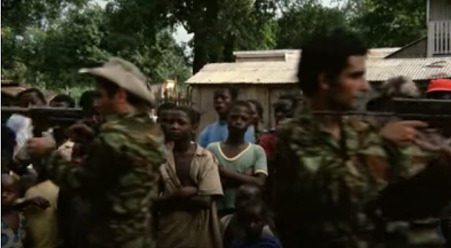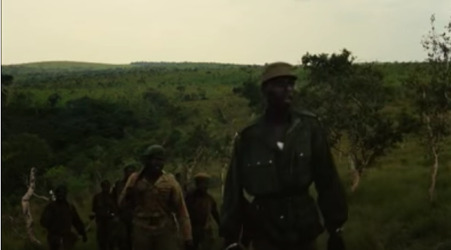#Der Leone Have Sept Cabeças
Explore tagged Tumblr posts
Text


Glauber Rocha
- The Lion Has Seven Heads / Der Leone Have Sept Cabeças
1970
#Glauber Rocha#The Lion Has Seven Heads#Der Leone Have Sept Cabeças#Der Leone Have Sept Cabecas#1970#film
171 notes
·
View notes
Photo

O leão de sete cabeças (Der leone have sept cabeças), de Glauber Rocha (Brasil/Itália/França, 1970)
2 notes
·
View notes
Text

309. O Leão de Sete Cabeças (Der Leone Have Sept Cabeças, 1970), dir. Glauber Rocha
1 note
·
View note
Photo

"O principal problema da luta anticolonialista é a destruição do complexo de inferioridade nacional." O Leão de Sete Cabeças (Glauber Rocha, 1970)
#quote#movie quote#glauber rocha#der leone have sept cabeças#o leão de sete cabeças#brazil#congo#congo-brazzaville#giulio brogi#1970
13 notes
·
View notes
Photo

Der Leone Have Sept Cabeças, Glauber Rocha (1970)
#Glauber Rocha#Gianni Amico#Rada Rassimov#Giulio Brogi#Gabriele Tinti#Jean Pierre Léaud#Aldo Bixio#Baiack#Reinhard Kolldehoff#Guido Cosulich#Baden Powell#Eduardo Escorel#1970
8 notes
·
View notes
Text
november in review: books and film
(favorites in bold)
books:
las elegidas, jorge volpi
la hojarasca, gabriel garcía márquez
rendición, ray loriga
mona, pola oloixarac
tres chicos buenos, pablo wessling
farsa de la india, gil vicente
el olvido que seremos, héctor abad faciolince
film:
la monja alférez (1944), mexico
la llamada (2017), spain
der leone have sept cabeças (1970), brazil
vidas secas (1963), brazil
deus e o diabo na terra do sol (1964), brazil
hope to have some more free time in december, but i think this was a pretty good amount :)
8 notes
·
View notes
Text


Der Leone Have Sept Cabeças (1970, Glauber Rocha)
15 notes
·
View notes
Photo


[84] Der Leone Have Sept Cabeças / [Polylingual title—‘The Lion has Seven Heads’] (1970, dir. Glauber Rocha)
Ironically, it was at the height of his fame as an exponent of a specifically cinema that Rocha was exiled from Brazil and began to operate within a European framework, seeking funding wherever he could. ‘Antonio das Mortes’ had effectively put Brazil on the international (read: European) cinematic map, providing a populist left-wing icon that combined the appeal of the ‘Zapata westerns’ with that of the left-leaning arthouse crowd, coincided with Rocha’s (self-imposed) European exile, yet Rocha was now cut off from the folk practices which gave his early films their force: the cangaceiro myths of ‘Antonio’ and ‘Black God’, the cadomblé of ‘Barravento’. His embrace of identity as a ‘tricontinental’ filmmaker, and consequent depiction of the Third World thus in turn becomes more generalised, at once suggesting solidarity along the lines of tricontinentalism, and reflecting an unmooring from the specificities of Brazilian cultural production. During the 1970s, Rocha shot films in the Democratic Republic of the Congo (‘Der Leone’), Spain (‘Cabezas Cortadas’) Italy (‘Claro’) and, as part of a collective production, the documentary ‘As Armas e o Povo’ on the 1974 carnation revolution in Portugal. In other words, he participated in the political questions both of the European ‘West’ (including its dictatorial, military aspects) and the decolonising ‘Third World’. Beginning with ‘Der Leone’, Rocha gives new meaning to the term ‘international coproduction’. If this new confluence of state and private funding arose in part from the inability of national cinemas to compete with Hollywood, it also enabled the production of a notably left wing, third wordlist cinema—the ‘Zapata westerns’, films like Bertolucci’s ‘Novecento’, Pontecorvo’s ‘Battle of Algiers’ and ‘Quiemada’. The film’s cast is international and, though the film is shot primarily in French, each the five languages that form its title are also spoken. Rocha thus insists, while operating from a perspective informed by the particular experience of brazil, that the film is international, in terms of filmic influence—he mentioned Brecht, Einstein and godard in relation to this film, along with cinema novo—and the issues of colonialism, an international phenomenon. ‘Der Leone’ differs from almost all existing models of political cinema: the Maoist—but white and European—left found in Godard’s work from ‘La Chinoise’; realist depictions of revolution (Pontecorvo); neorealism; the attempt to create empathy for the struggles of the oppressed. Instead, he turns to allegory and dream, not just as one element, but as influence on total structure, at once stressing the technological mediation of cinema in a firmly materialist manner and insisting on the importance of an apocalyptic, revolutionary mysticism to its conceptualisation of politics, resistance, revolution. Thus, Rocha at once emphasizes the defamilisarising—‘modernist’—elements of his previous work, bringing together a secular, materialist tradition—Brecht, Godard—with the ecstatic, the mystical and the musical that differed sharply from such models. If Rocha’s Antonio films had borrowed their figuration from existing folk myth and, to a lesser extent, film trope—St George, the cangaceiro, the landowner, the cowboy—the allegorical canvas here is broader and more international. Unlike Godard—who avoided Africa—or Pasolini—whose African and Arabic settings were, to say the least, romanticised—Rocha took seriously the possibility of Africa as part of the tricontinental axis. His African extras are not anthropological specimens but real people, sometimes laughing at the actions they’re asked to perform: in one key moment, the camera zooms past the European actors and lingers on the faces of the crowd who watch them with a kind of defiant bemusement that extends to the filmmaker himself. The scenarios sees the tricontinental revolutionaries—associated with Zumbi, the Black Brazilian founder of the quilombo community Palmares, with African leaders such as Cabral, and with Che Guevara—unite against Marlene, the Aryan figure identified with the seven-headed beast of the apocalypse and with the mendacious forces of money and European colonial ideology, and her henchmen—a series of European mercenaries and the neo-colonialist ruler from the African national bourgeoisie. At the films end, a procession of militants in guerrilla fatigue slowly march up the hill, singing a revolutionary song. The protagonists of ‘White God’, Paulo in ‘Terra em Transe’, or Antonio in ‘Antonio das Mortes’, who end those films stuck on the edges of things with no way out—the coast, the desert, the endless road—with no way out. Here, however, the militants, unlike those isolated figures, move as a group and march with a purpose, even if it’s not clear where they’re heading. Moreover, their song unites art and struggle: the song and the machine gun, the spear and the dance are connected. Rocha’s exilic internationalism is thus refigured as space of possibility as well as the product of political catastrophe. At this point, there was evidently a world to win.
1 note
·
View note
Text
ELFI TURPIN

Mercredi 27 mai à 18h (heure de Paris)
Wednesday May 27, 6pm (Paris time)
Bonjour à vous ! Nous vous espérons en bonne santé, vous, vos proches, où que vous vous trouviez confiné·es. Ce séminaire aura lieu en ligne via Zoom Le nombre de places étant limité, Il est nécessaire de s’inscrire préalablement : [email protected] Hello Everyone! We hope you and your loved ones are well and safe. This seminar will take place online via Zoom The number of attendees is limited, please register at this address if you wish to attend: [email protected]
Elfi Turpin est curatrice. Elle dirige depuis 2013 le Centre Rhénan d'Art Contemporain – CRAC Alsace à Altkirch en France. Au travers d’expositions, de publications et de pratiques discursives collectives, elle collabore dans une grande proximité avec les artistes et les publics autour de projets spécifiques qui engagent de longs temps d’expérimentation et d’échanges. Elle enchevêtre depuis 2013 au CRAC Alsace une variété d’expositions structurant le centre d’art qui se transforme avec elles. Par exemple : Le couteau sans lame et dépourvu de manche ( 2019), Le jour des esprits est notre nuit, avec la curatrice Catalina Lozano (2019), Edit Oderbolz: Water Your Garden In the Morning (2019), Armando Andrade Tudela: Working And Then Not Working (2018), Jarbas Lopes: e’a’u’ (2017), Natalie Czech: One Can't Have It Both Ways And Both Ways Is The Only Way I Want It (2016), Musa paradisiaca: Alma-bluco (2015), Sophie Nys: Ein Tisch ohne Brot ist ein Brett (2015), Daniel Steegmann Mangrané: Animal que no existeix (2014), Der Leone Have Sept Cabeças, avec la curatrice Filipa Oliveira (2014), Elisabetta Benassi: Smog a Los Angeles (2013), Susan Vérité, des méthodes (2013). Pour ce séminaire, Elfi Turpin aimerait partager et questionner des méthodologies, préoccupations et actions situées dans un centre d’art, qui est lui-même situé dans une petite ville dans le sud du Haut-Rhin à quelques pas des frontières suisse et allemande, et aujourd’hui très affectée par l’épidémie.
[EN] Elfi Turpin is a curator. Since 2013, she is the director of Centre Rhénand'Art Contemporain – CRAC Alsace, Altkirch, France. Through writings, exhibitions and discursive practices, she collaborates with artists and audiences on very specific projects engaging long-term researches and exchanges. Conceived as a collective process, the exhibitions she has curated at CRAC Alsace are entangled with one another. As such, each exhibition both structures and transforms the art center: ‘The Knife Without a Blade That Lacks a Handle’ (2019); ‘Le jour des esprits est notre nuit’, in collaboration with Catalina Lozano (2019), ‘Edit Oderbolz: Water Your Garden In the Morning (2019); ‘Armando Andrade Tudela: Working And Then Not Working’ (2018); ‘Jarbas Lopes: e’a’u’(2017); ‘Natalie Czech: One Can't Have It Both Ways And Both Ways Is The Only Way I Want It’ (2016); ‘Musa paradisiaca: Alma-bluco’ (2015); ‘Sophie Nys: Ein Tisch ohne Brot ist ein Brett’ (2015); ‘Daniel Steegmann Mangrané: Animal que no existeix’ (2014); ‘Der Leone Have Sept Cabeças’, in collaboration with Filipa Oliveira (2014); ‘Elisabetta Benassi: Smog a Los Angeles’ (2013); ‘Susan Vérité, Methods’ (2013), among others.
Elfi Turpin would like to engage this seminar in sharing and questioning methodologies, concerns, and practices situated in an art centre, itself situated in a small town in the south of the Haut-Rhin, a few steps away from the Swiss and German borders, and today very much affected by the pandemic.
Programmation et prochains rendez-vous sur ce site ou par abonnement à la newsletter : [email protected]
Pour regarder les séminaires antérieurs : http://www.vimeo.com/sysk/
Séminaire conçu et organisé par Patricia Falguières, Elisabeth Lebovici et Natasa Petresin-Bachelez et soutenu par la Fundación Almine y Bernard Ruiz-Picasso para el Arte
0 notes
Text

Film du Jour: Der Leone Have Sept Cabeças - 1971 - Glauber Rocha
17 notes
·
View notes
Photo

“O principal problema da luta anticolonialista é a destruição do complexo de inferioridade nacional.”
#glauber rocha#o leão de sete cabeças#der leone have sept cabeças#the lion has seven heads#cinema#quote#film#brazil#congo#third cinema#movie quotes
9 notes
·
View notes
Photo

Der Leone Have Sept Cabeças (1970)
#der leone have sept cabeças#o leão de sete cabeças#the lion with seven heads#glauber rocha#cinema#film#brazilian cinema#cinema brasileiro
1 note
·
View note

